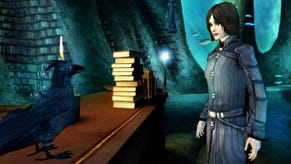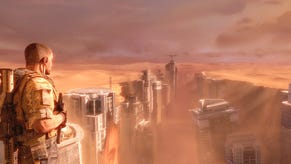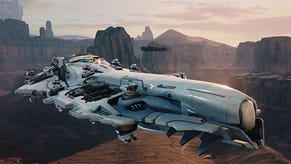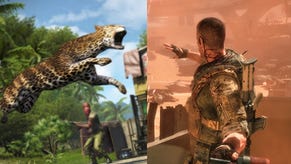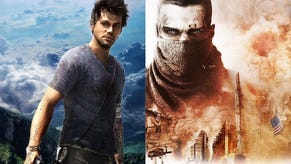Hands On: Spec Ops: The Line
Some hold it, some walk it...
As I sat in 2K’s lobby waiting to play Spec Ops: The Line, a man played The Darkness II on a nearby consolebox. If I were to estimate, I’d say 84% of his time was spent eviscerating people, tearing them limb from limb, punching gaping holes through their most precious parts and lopping off their screaming faces with a twitch of his tentacles. It truly was one of the most gruesome displays I’ve ever been witness to. That man was Shawn Frison, senior designer at Yager Games. In Spec Ops, he has helped create something far more brutal than the comic book killfest of The Darkness.
Craig has already taken a look at Spec Ops but we were invited back to play more and to talk to Shawn. The demonstration build that I was left to play in privacy, albeit on a 360, begins with an on-rails vehicle section that seems intended to highlight the verticality of the setting, with helicopters weaving between the skyscrapers as a sandstorm swirls around them, threatening to send them spinning out of control. Although it’s a spectacular sequence, it doesn’t feel like the best way to introduce the offbeat and colourful setting that is the ruined luxury of Dubai.
Gladly, the narrative cuts back to the arrival of the three Delta Force operatives who have been sent to the beleaguered city to rescue the Kurtz-like Colonel John Konrad. The name alludes to Joseph Conrad and the game itself is partly a retelling of Heart of Darkness, with the journey into the buried city very much a voyage into the darkness that lurks within the souls of men. And what darkness it is. There are bodies piled high in the ruins and many of them are the bodies of the unarmed. They are victims, not combatants.
Despite all the horror, I wasn’t left with the queasy sense of sensationalism and headline-grabbing that some military man-shooters have instilled in recent years, and that’s partly because Spec Ops has a strong element of the fantastic. Dubai is an otherworldly place even without the bloodied, stained light that struggles through the clouds of sand. In this almost post-apocalyptic state, with Konrad and others maniacally commenting on the squad’s progress through loudspeakers and music filtering in from the decks of some demented DJ, this doesn’t feel like something that could happen but rather a reification of madness in which the violence mostly feels grubby rather than fetishized.
There are tonal inconsistencies, which is perhaps inevitable in a game which wishes to convey the horror and madness of war, while having a main objective of shooting people for fun. That said, in the chapters I played, which began at the beginning but jumped to later points in the game, there are some well-staged scenes between the squad that show their mental state eroding as quickly as the dying city around them. Indeed, it’s mostly the early dialogue that bristles uncomfortably, with a few too many swears thrown in to really hammer home the grittiness of it all.
In between the shouting and screaming, there’s a whole lot of shooting. Thankfully, with it being the core of the game, it’s good shooting. With a third-person control scheme that will be familiar to anyone who has played Uncharted, Spec Ops is a game of cover, simple squad commands and lethality. Why draw attention to lethality in a genre very much about killing? Because the weapons in Spec Ops cut people down quickly and effectively. One bullet to the head will not only drop someone, it will more than likely take their entire head off. Shoot them in the legs and they stumble or fall, ready to be stamped out of existence.
It’s a relief because the games it most reminded me of – Gears of War and Uncharted – suffer greatly to my mind from making their own meaty weapons feel like Nerf guns by having enemies who keep standing when they are perforated from head to toe. Gunning down a distant rebel with a rattling burst of fire, knowing that he won’t simply soak up the bullets and spit them out, is intensely satisfying.
Particularly in a cover-based shooter, it makes sense for bullets to be deadly things rather than the equivalent of bee stings. If I could take a shotgun blast to the face and barely react, I’d be less likely to spend my life hiding behind a pot plant. In fact, I’d show up at parties with a shotgun and repeatedly blast myself in the face to impress people. Eventually, I’d take the act on tour, never letting people know that despite my resistance to speeding projectiles, a single punch to the face kills me instantly, as do the same bullets that I catch in my teeth and eat for breakfast if the person firing them has crept up on me.
Other than that, the combat has much in common with Uncharted and that’s not just because it features Nolan North’s voice running around in a desert. Blind-firing from cover or aiming and exposing oneself are the main approaches to combat, although shotguns are much easier to fire from the hip, providing a targeting reticule and decent accuracy at short range even while moving from cover to cover. That helps to make weapon choice more meaningful, as does the two gun limit, although with ammo often sparse, I was quite often forced into taking whatever shooty-stick I could loot from the tattered corpses I’d created.
Grenades come in three varieties - frag, stun and sticky – and are lobbed with an overlaid arc for assistance, making them unerringly accurate. Even a normal frag grenade can stun a group of enemies that are outside its blast radius if it is thrown onto sand, which billows up in a cloud when disturbed, causing confusion and panic. The almost constant chatter between enemies and squadmates helps to convince of their intelligence, which is a familiar trick and here it's a well-executed one. It’s usually clear what kind of tactic is being used based solely on the shouted commands and as numbers are depleted, plans change and there’s a greater tendency to stay in hiding. My allies would often curse me as I charged an enemy position, ordering me to take cover.
The three of us aren’t as weak as the enemies - although I wonder if that will be the case on the hardest difficulty setting - but we’re not invincible either. The death of a companion ends the game and although I didn’t see it happen, I did have to abandon a firefight to stop one of my buddies from bleeding out. They’ll help each other too and on the whole they operate independently, although it is possible to instruct them to target specific enemies, or to use stun grenades in order to create an opening. They get on with things though, actually proving useful at the whole killing business, which I guess is what makes their ops so special.
I left with a feeling of pleasant surprise. Yager’s vision of Dubai is strong, with the sand almost a character in itself, and the almost surreal edge prevents this from being another gritty military shoot ‘em up. There are times when the sheer depravity of combat has the power to shock and one sequence, which I won’t spoil, is particularly gruesome. It contains what seems a deliberate nod toward Modern Warfare but then forces the player to stare at an aftermath that is more disturbing and grotesque than I’d anticipated.
What that level of horror needs is impact, not on the player but on the characters. If we don’t believe that they are being changed by what they are witnessing, we won’t believe in Konrad, who seems to have lost every single one of his marbles. From what I’ve seen, the squad become more interesting as they begin to question one another and the decisions made by the player; they’re more desperate and more human, rather than being macho murder-machines with a vocabulary of four letter words. The scale of the levels and enemy placement also left me longing to plug in a mouse and keyboard. We don’t see many third-person shooters of this sort on the PC and if the controls are implemented well, they could make the aiming seem less sluggish than it sometimes did.
The intro sequence aside, the most awkward part that I played was a shoot-out in a multi-level mall. It was the one point where I couldn’t find the way forward, so ended up killing endlessly respawning enemies for five minutes or so. The illusion was broken and for all their talk and unpredictability, the enemy soldiers were suddenly nothing more than targets popping up in a shooting gallery. It stood out from the other chapters I played, being the only piece of level design that didn’t visually guide the player.
If the full game contains more of the large spaces and environmental interactivity, and less of the chugging spawn points, the actual shooting mechanics are solid, backed up by impressive animation and punchy weapons, and that should be enough to entertain throughout what's shaping up to be a surprisingly compelling grimdark story.
We’ll have an interview with senior designer Shawn Frison later this week, in which we talk about the Apocalypse Now influence, the difficulty of balancing horror and entertainment, and going to barbeques with a man who has killed on the field of battle.






